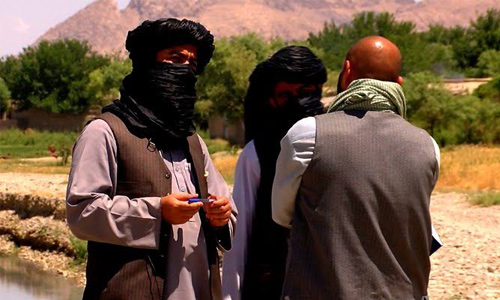It was undoubtedly a major strategic blunder of ISIS to opt Afghanistan as their base for recruitment and recuperation. They were never welcomed here. The US forces bombed them from the skies and simultaneously, the Afghan security forces and local uprising groups dealt them on the ground and the Taliban too challenged them on the battlefield and defied their version of Islam.
“We have eliminated Daesh” the Afghan President Ashraf Ghani boasted by declaring victory over Islamic State in Nangarhar, eastern Afghanistan. President Ashraf Ghani visited Nangarhar on Tuesday, to celebrate the occasion by expressing gratitude to the tribal elders for their sacrifices and resistance, paid tribute to the fallen soldiers and members of the local uprising groups who valiantly stood against the atrocious rule of Daesh and congratulated the nation for incapacitating, if not eliminating, the terror group.
The celebrations were owing to the surrender of 243 demoralized ISIS fighters who surrendered along with their families, including many children and women, to the Afghan government as a consequence of the anti-ISIS operations since the declaration of Islamic State in Khorasan Province (ISKP) in 2015. Interestingly, the majority of the surrendered fighters belonged to Pakistan, followed by Tajikistan, Uzbekistan, Iran, Azerbaijan, Kazakhstan, and Maldives. The miscalculated gambit of the Islamic State of Iraq and Levant (ISIL) to solidify its lost base and prolong its outreach from Afghanistan seems leading to imminent failure.
The Islamic State in Khorasan Province was declared by the spokesperson of ISIL, Abu Muhammad al-Adnani, in January 2015 which encompassed the territories of Pakistan, Afghanistan, and parts of Central Asia—intending to revive the historical Khorasan region. ISIL was eyeing the contested and ungoverned territories in Afghanistan but initially, the Afghan government refuted ISIL’s declaration of ISKP, however, they were helpless when they announced their ghastly arrival on the scene with a gruesome suicide blast in Jalalabad, killing 35 people and wounding 100, queued to collect their wages. The new terror group instantly secured the allegiances from the disgruntled and opportunistic commanders of Pakistani Taliban and individuals from the tribal areas of Pakistan formerly known as FATA. In fact, the first governor of ISKP was the former commander of the Pakistani Taliban in the Orakzai agency, Hafiz Saeed, a native Pakistani. According to John Nicholson, “70 percent of ISKP members were former members of Pakistani Taliban who were driven to Afghanistan by the military operations in FATA.” The group continued its terrorist attacks unabatedly with no regard for human lives. According to Global Terrorism Index, ISKP surpassed the Taliban in conducting the worst terrorist attacks in 2017, with the Zanbaq Square in Kabul and Sehwan in Sindh, Pakistan, being the most ferocious, killing 93 and 91 people respectively. In 2018, the terror group continued to inflict significant casualties. In Dashte Barchi, Kabul, a suicide bomber killed 70 people at the voting registration center only to be followed later with the carnage of 56 religious scholars celebrating the birth of Prophet Muhammad.
Since the inception of ISKP, the Afghan civilians especially those living in Achin, the first capital and stronghold of ISKP and other districts of Nangarhar, have met a fate of misery and unimaginable agony. Life under their rule was a nightmare in reality, characterized by forced marriages, torture, and closure of schools, the enforced inclusion of teenagers in their fighting ranks and subsequent displacement of tens of thousands of families.
Despite the horrible damages inflicted on Afghan civilians the ISKP could not sustain any popular legitimacy even by coercion let alone securing it through their so-called puritanical deeds. The tribal elders in eastern Afghanistan stood against their tyranny, the true unsung heroes who risked their lives and gave extraordinary sacrifices, by forming the uprising units to repel the Daesh insurgents from their constituencies. The fierce anti-Daesh operations conducted by the Afghan National and Defense Security forces and supported by the US airstrikes caused them unprecedented damages with the extermination of 1600 foot soldiers and decapitation of its 20 top leaders. The Afghans have discarded their brand of Islam, even the late head of Taliban Akhtar Muhammad Mansour had written a letter to the leader of takfiri ideology, Aboubakar al Baghdadi, warning him clear and loud “that there is room for only one flag and leadership”. Daesh in Afghanistan had to survive in a very congested space: fighting against the US and Afghan forces, the uprising units and occasionally the Taliban due to their ideological differences.
The partial, yet significant, victory of Afghan military forces over the Islamic State terror organization in eastern Afghanistan is a remarkable achievement for the Afghan army which manifests the courage, commitment, professionalism and bravery of an army which was formed only after 9/11. Furthermore, it also disheartening to see the negligible mainstream media coverage devoted to this outstanding feat. However, the threat of ISKP is not over yet, just like the diversity of the surrendered IS insurgents suggest that it is an entirely ‘foreign’ entity and disdained phenomenon which can only be defeated completely by a collective mechanism involving the concerted efforts of the regional states. The threat of IS terrorism and its prospects in Afghanistan are largely overestimated by many western media outlets which hold Afghanistan a favorable environment for the IS insurgents, ignoring the fact that Daesh enjoys not only limited operational space but also the minutest of political and ideological support from the Afghans. Moreover, it is not an indigenous movement like the Taliban which can be successful in sustaining their operational objectives in the long run with some support from the local populace. The terror group has lost one of its major stronghold in the east, its local collaborators are neutralized in search and combing operations by the Afghan special operation forces and they are constantly pounded in the north. Daesh in eastern Afghanistan is gone, hopefully forever.
Home » Opinion » Islamic State in Afghanistan: Between a Rock and a Hard Place
Islamic State in Afghanistan: Between a Rock and a Hard Place
| Samiullah Doorandesh

